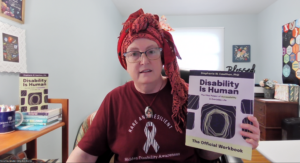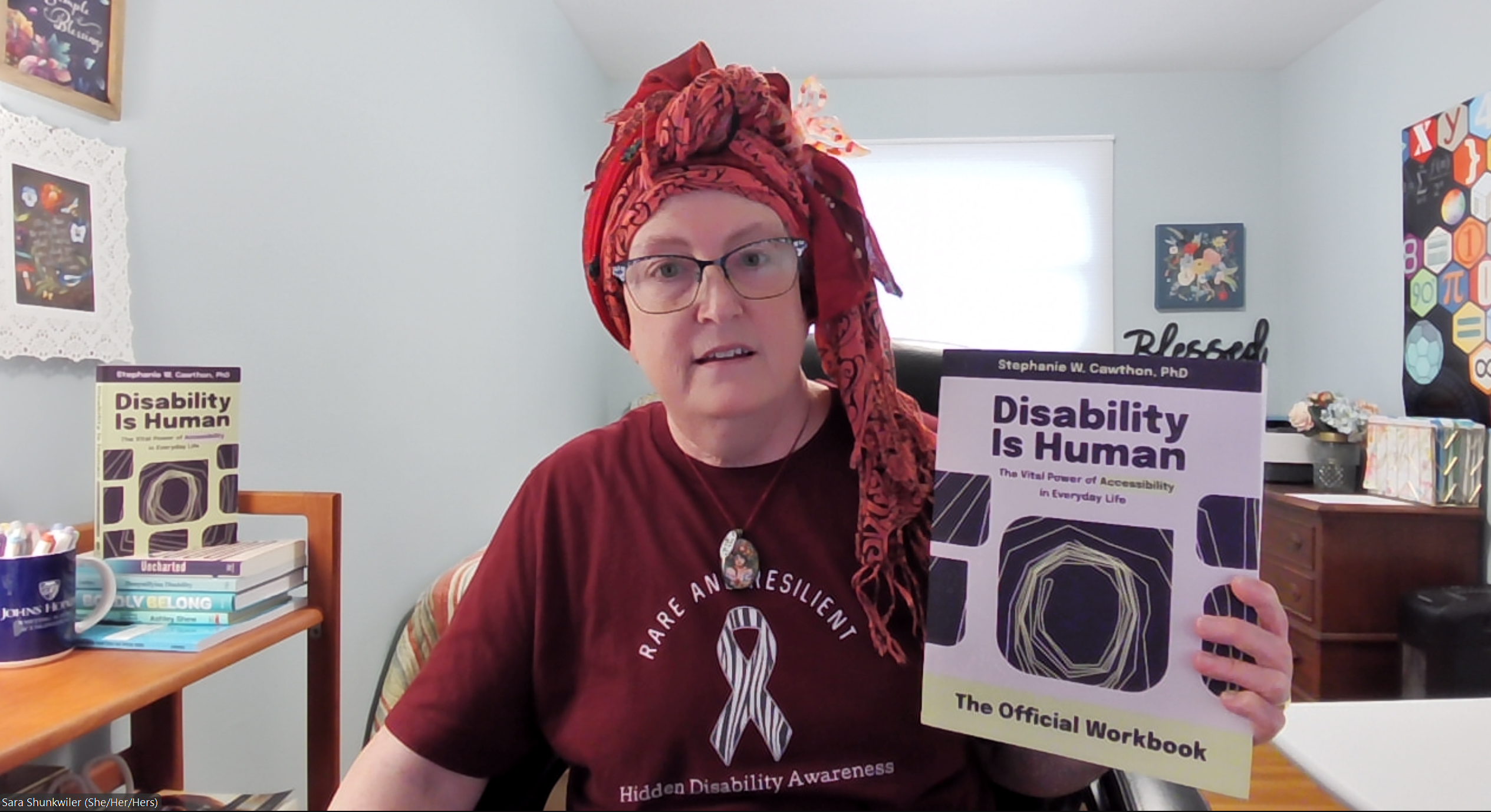Summary
STEM educator and disability advocate Sara Shunkwiler reviews Disability Is Human and shares her insights on the book and workbook.
This guest blog post by Sara Shunkwiler is a review of Disability Is Human: The Vital Power of Accessibility in Everyday Life. At Johns Hopkins University, Sara is an Instructional Designer at the Whiting School of Engineering and Adjunct STEM Faculty at the School of Education.

Image description: Sara Shunkwiler (she/her/hers) is a middle-aged, cisgender, white female wearing glasses, a colorful headscarf, and t-shirt that reads “Rare and Resilient, Hidden Disability Awareness” with the rare disease zebra ribbon. She is holding up a copy of the Disability Is Human workbook with the book on the adjacent shelf during an interview with the STEM Positive Disruptor podcast.
I am a disabled engineer, adjunct STEM faculty, engineering course designer, and frequent presenter on disability inclusion at Johns Hopkins University Whiting School of Engineering. I’m not a paid reviewer and get no benefit from sharing my thoughts other than to change the future of who gets to be in STEM and Medicine!
Disability IS human. To quote Jamie Shields at Disabled by Society, “Disability is part of the human experience. We are your friends. We are your family. We are your colleagues. We are YOU, potentially some day.” (Shields, 2024)
“Disability is the essence of diversity, by definition. It runs across race, ethnicity, gender, socioeconomics, culture and the most important thing, it’s the only minority group anyone can join at any time, which makes it unique. It’s a community that actually embraces inclusion by definition.” — Jonathan Kaufman (Source America, 2020).
I’ve been looking forward to Dr. Cawthon’s book and workbook, because I often present at workshops and conferences about disability inclusion and the challenges of disclosure due to stigma and bias. I include the statistics and an extensive literature review, but I start with our stories. Disability Is Human includes both the background to build context and our individual and collective stories to share the human faces of disability. It is divided into 3 sections on Understanding Disability, Rooting Out Ableism, and Cultivating Accessibility.
Even though I have been disabled for most of my adult life, I didn’t identify as disabled. I was unaware that there is a vital and thriving disability community and had never heard the term ‘ableism’ until about 2 years ago. I was charged with creating a training course for our engineering faculty about how to implement accommodations for disabled students. While I’ve worked with and advocated for disabled students for over 20 years, jumping into accommodation without building a foundation on why they are still needed seemed like the wrong place to start.
An extensive literature search and conversations with our Student Disability Services office ensued, and in that process, I found my own disability identity. Dr. Cawthon’s book pulls that research, personal stories, and conversations together in one place. Another faculty member challenged me to own my disability story saying our students, faculty, and colleagues need disabled role models. I have become a frequent workshop and conference presenter on why disability inclusion is vital to the future of STEM and Medicine, and how we can all join the conversation.
I was asked in a panel discussion on Voices of Accessibility if I have advice for other people who are uncomfortable talking about disability. My response was, “I’m still not comfortable talking about it. I just do it more often now.”
If you are hesitant to get involved, fear not. We WILL get it wrong in conversations and interactions together, but that’s OK! Disability IS Human – it’s a personal and collective experience that varies from person to person, culture to culture, place to place, and even within a single human given the day, time, or circumstances.
I highly suggest the companion workbook, as well, and believe anyone who wishes to take notes or reflect while reading will enjoy the section called ‘Reflection Exercises’. Anyone planning a workshop, meeting, or discussion will appreciate the sections called ‘You and Your Team’ and ‘An Accessibility Workshop-Building Template’. These follow the same steps I use to create inclusive and accessible meetings. Even if you aren’t planning a formal workshop, there are guiding principles that would be applicable to team meetings, K12 and HigherEd classes, and community events.
The final section, ‘Group Activities’, has a wealth of ideas on how to open up the conversation about disability. Conversations about identity can be uncomfortable, and we may fear engaging in case we get it wrong. As Kaufman so aptly pointed out, disability runs across every other identity, which serves to both unite and divide and make us hesitant to engage in conversations.
In the attached photo, I was holding up the workbook with the book on my shelf during an interview for the STEM Positive Disruptor podcast channel ‘Disability MIA’ series on why people with disabilities are missing in STEM and Medicine.
My mantra is Grounded in Research – Equitable by Design. The Disability Is Human book and workbook will indeed help create change by sharing “The Vital Power of Accessibility in Everyday Life.”
